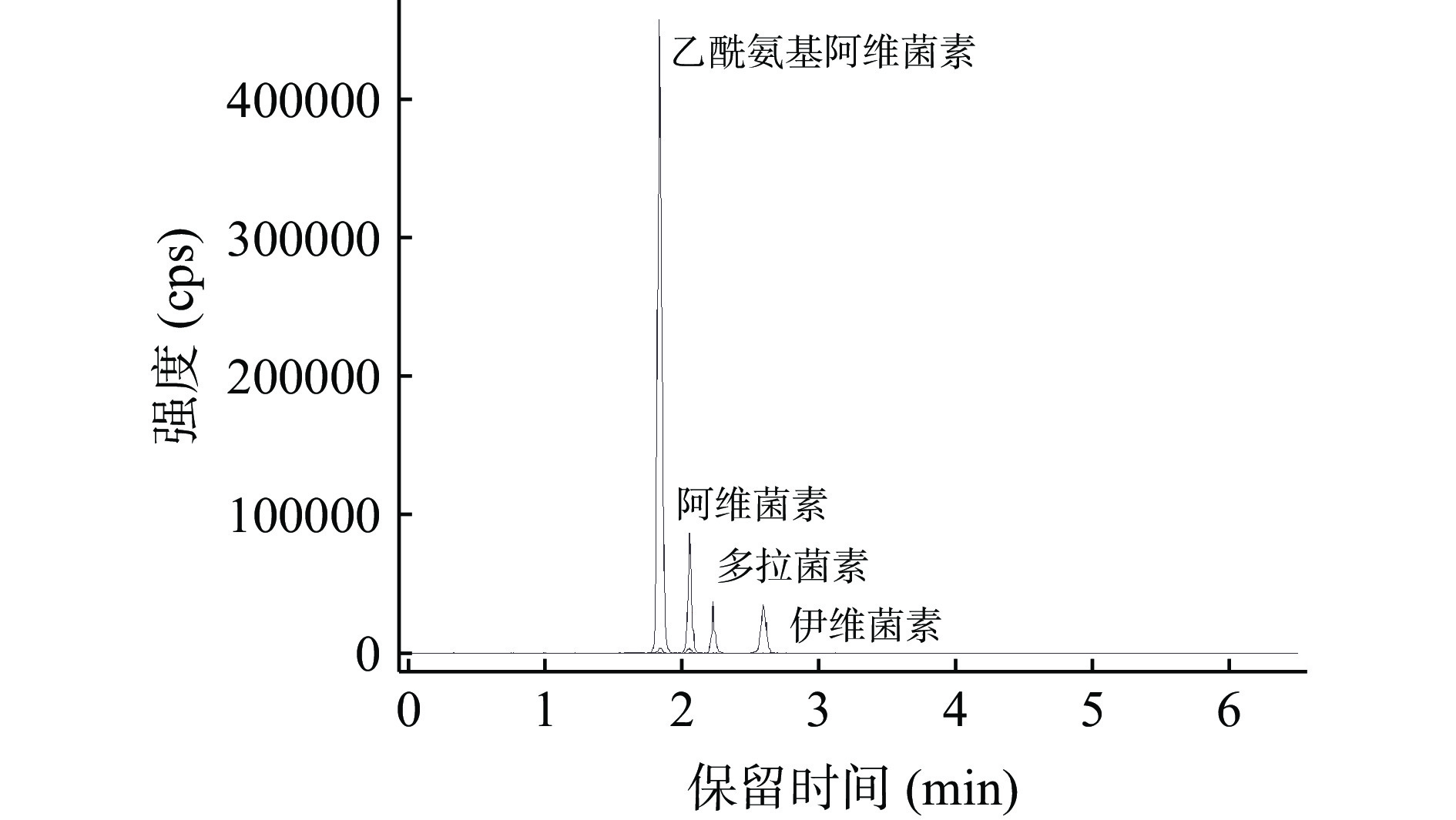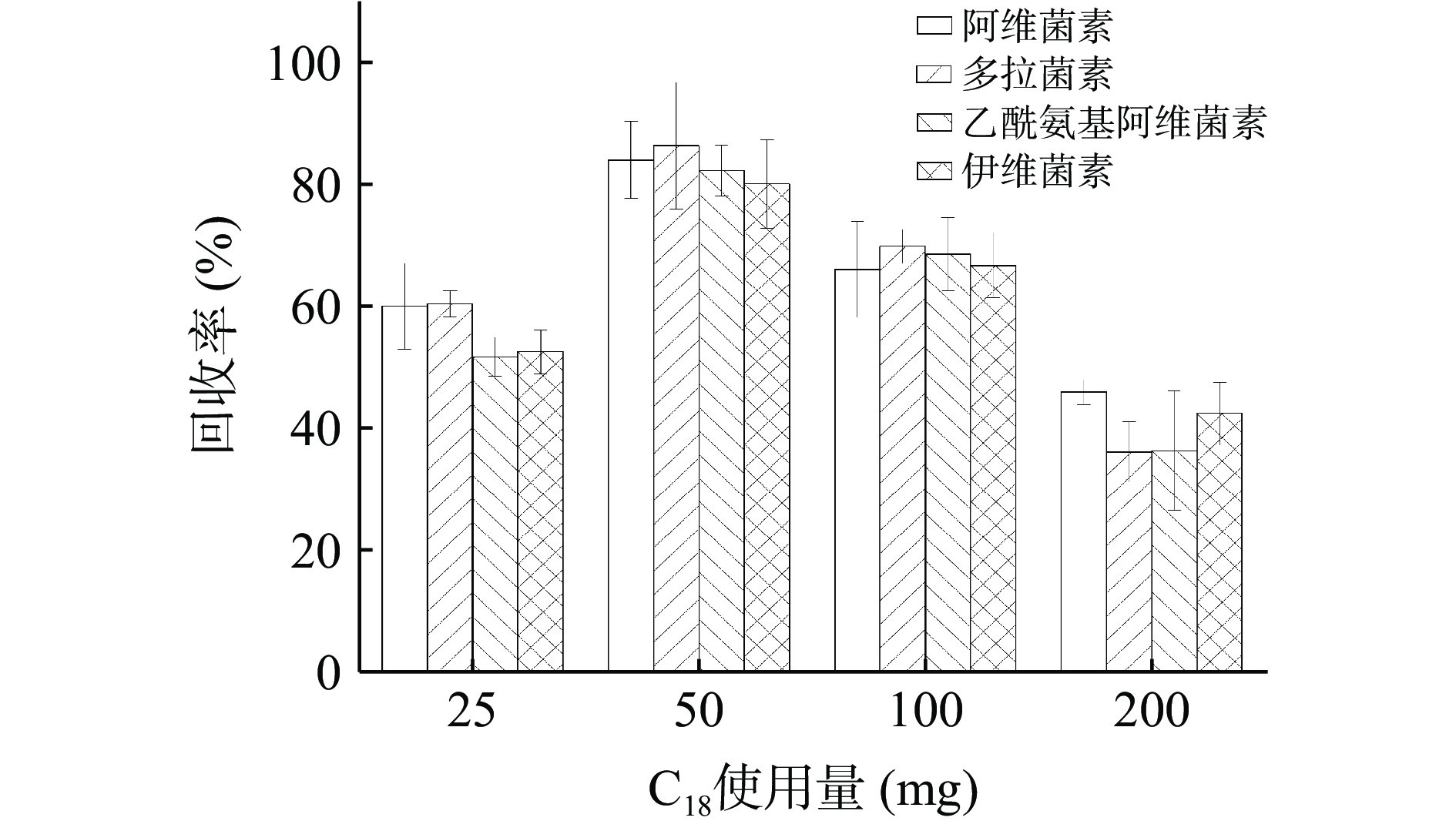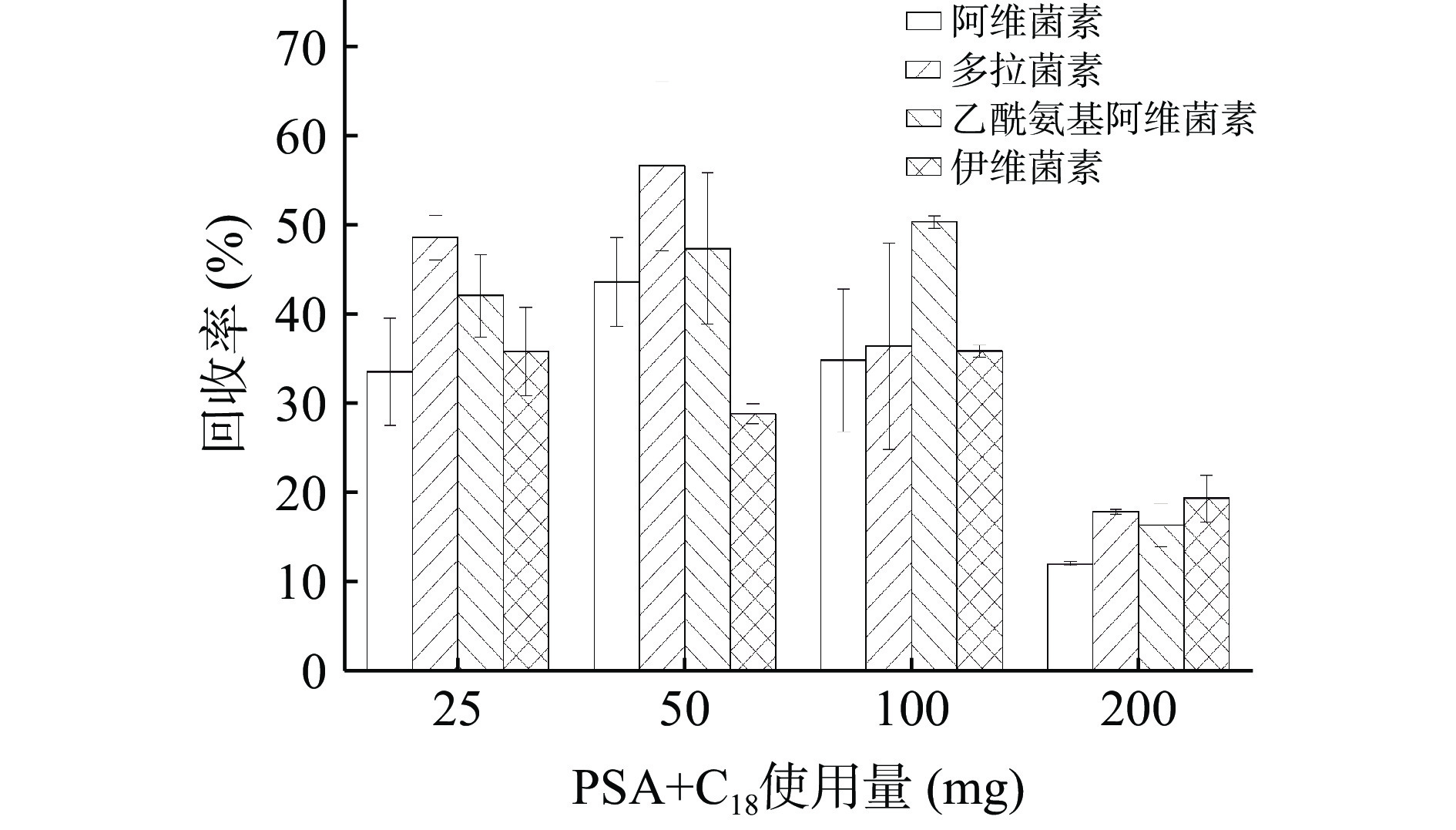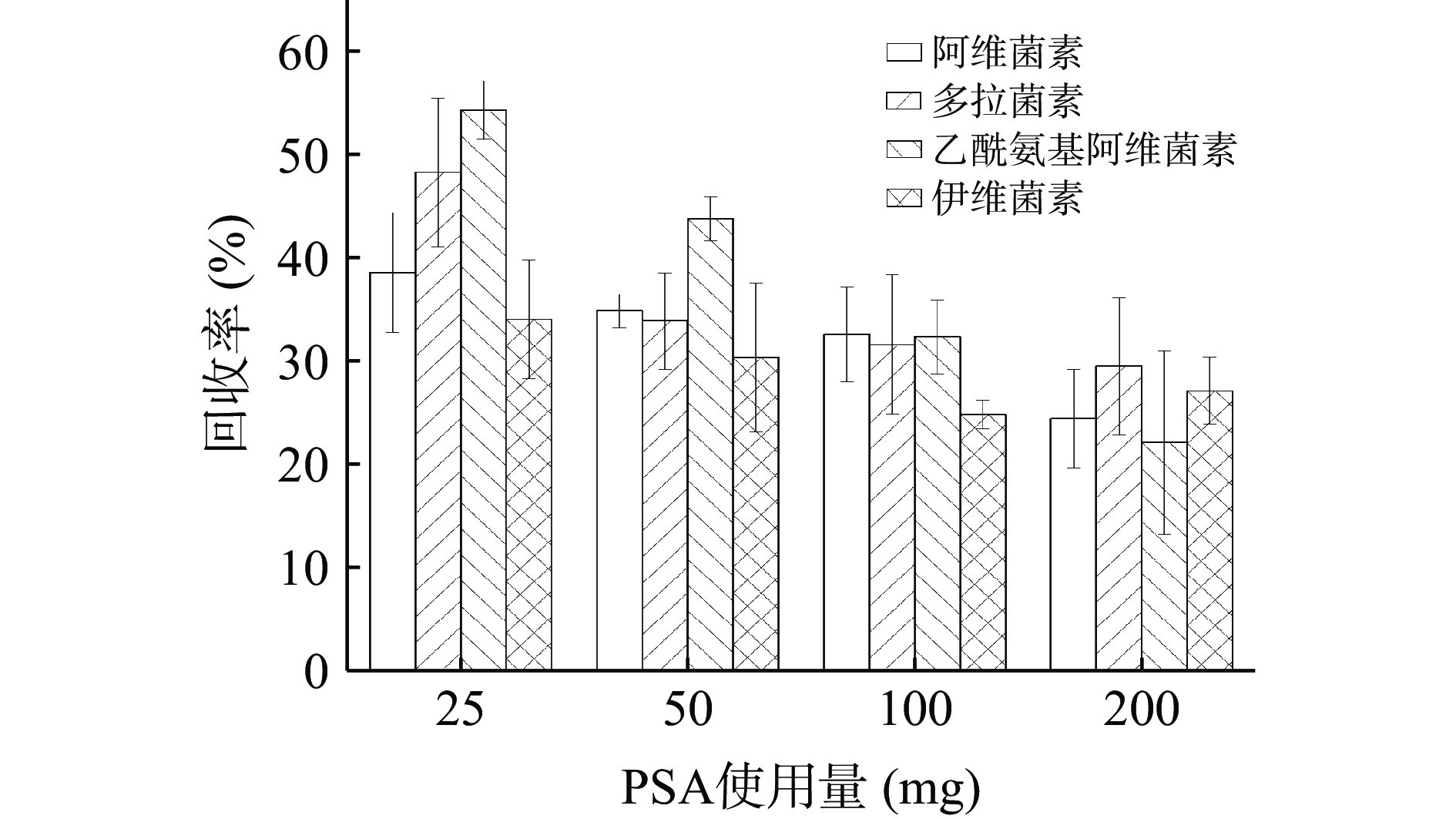Analysis of Four Avermectin Drugs Residual Levels in Rose Flower Cakes and Chronic Dietary Risk Assessment
-
摘要: 为了解玫瑰鲜花饼中是否存在药物残留情况,以及是否存在慢性膳食摄入风险情况。本文通过检测玫瑰鲜花饼中四种阿维菌素类药物的残留情况,对其药物残留进行水平分析,评估其慢性膳食摄入风险。四种药物分别是阿维菌素、多拉菌素、乙酰氨基阿维菌素、伊维菌素。共收集了43种玫瑰鲜花饼样品,采用优化的QuEChERS方法对样品进行前处理,并用高效液相色谱-串联质谱仪来测定这4种化合物的残留水平,对它们进行慢性膳食摄入风险评估及风险排序。结果表明,四种阿维菌素类药物标线的判定系数均大于0.99,检出限的范围为0.1~0.7 µg/kg,回收率范围为94.97%~102.09%,四种目标化合物只有阿维菌素被检出,检出率是79%,残留量范围为1.89~4.58 µg/kg。对四种药物进行食品安全指数分析(IFS),阿维菌素为1.3×10−3、多拉菌素为1.0×10−4、乙酰氨基阿维菌素为1.7×10−6、伊维菌素为1.2×10−5;对四种目标化合物进行风险评估,并进行风险排序,四种药物总分均低于50,说明目前鲜花饼中阿维菌素类药物的残留水平不高,风险较低。建议将其纳入食用玫瑰种植过程中农药登记名单并制定相应限量标准。Abstract: To understand whether there was a drug residue in the rose flower cake, and whether there was a risk of chronic dietary intake. In this paper, the residues of four avermectins in rose flower cake were detected, the residual levels of drug residues were analyzed, and the risk of chronic dietary intake was evaluated. The four drugs were avermectin, doramectin, acetylamineavermectin and ivermectin. A total of 43 rose flower cake samples were collected, and the optimized QuEChERS method was used to pre-treat the samples. The residue levels of the four compounds were determined by high performance liquid chromatography-tandem mass spectrometry, and their chronic dietary intake risk assessment and risk rank were performed. Results show that the four kinds of abamectin drugs line of correlation coefficient were greater than 0.99, the detection limit of the range of 0.1~0.7 µg/kg, recovery range of 94.97%~102.09%. Only avermectin was detected in the 4 target compounds, the detection rate was 79%, and residual range of 1.89~4.58 µg/kg. The food safety index analysis (IFS) of the four drugs was 1.3×10−3 for avermectin, 1.0×10−4 for doramectin, 1.7×10−6 for acetylavermectin, and 1.2×10−5 for ivermectin. Risk assessment on four kinds of target compounds, and to the risk of ordering, total four drugs were less than 50. This indicated that the residual level of avermectins in rose flower cakes was not high at present, and the risk was low. It was suggested that it should be included in the registration list of pesticides and the corresponding limit standards should be established.
-
云南作为中国的旅游大省,一直以来以其优美秀丽的自然景色闻名遐迩。同时云南也有着“亚洲花都”的美誉[1],是全国最大的鲜花供应地,占据着全国80%的鲜花市场。玫瑰鲜花饼是云南的一大特色美食,随着云南旅游业的飞速发展,玫瑰鲜花饼成为了云南的一张旅游名片,在全国乃至全世界都有了一定知名度,成为了热门的走亲访友伴手礼之一。在玫瑰的生长培育过程中,可能会存在各种病虫灾害,以白粉病、黑斑病和霜霉病为主,虫害以蚜虫、蓟马和红蜘蛛为主,这些病虫灾害都给玫瑰生长带来很大影响。为了应对病虫害,保证玫瑰花的产量,花农们会不得不给玫瑰使用一些农药。然而,在种植过程中使用的农药种类多、用药量大、施药次数多等问题可能会导致食用玫瑰中残留农药[2−7],从而使得玫瑰鲜花饼也具有农药残留产生的风险。在食用玫瑰的种植过程中,为了对抗病虫害,有时会使用到阿维菌素类药物来进行防治。而阿维菌素的残留会对人体神经系统及内脏等多方面产生损害[8−9]。伊维菌素、乙酰氨基阿维菌素、多拉菌素都是由阿维菌素衍生而来[10−11]。因此,本文主要研究玫瑰鲜花饼中阿维菌素、伊维菌素、乙酰氨基阿维菌素和多拉菌素的农药残留风险评估。
检索国内外文献和限量标准,目前国家标准、CAC[12]及欧盟[13]中都没有对食用玫瑰以及玫瑰鲜花饼的农药残留做出限量要求;关于食用玫瑰及鲜花饼的相关农药残留检验及慢性膳食摄入风险评估相关文献极少。Bian等[14]对食用玫瑰的种植、加工和浸泡过程进行了18种农药及其代谢产物的分析。说明了食用玫瑰花中具有部分的农药残留,对人体健康造成一定影响,但是18种农药并不包括本文研究的四种阿维菌素类药物,且他们研究的是食用玫瑰作为花茶饮用时的农药迁移率,并未涉及到玫瑰鲜花饼。检索国外文献,并未检索出有关于玫瑰鲜花饼的研究,关于食用玫瑰的相关文献也十分有限。以往对于单一品种蔬菜[15−17]、蔬菜类[18−21]、水果[22−24]、稻米[25]和茶叶[26−27]等食品中农药残留风险评估的研究较多,但是关于玫瑰鲜花饼的农药残留以及风险评估的研究极少。
为了解玫瑰鲜花饼是否存在慢性膳食摄入风险,对健康是否造成影响,展开玫瑰鲜花饼中的四种阿维菌素类药物残留的风险评估是很有必要的。对玫瑰鲜花饼进行农药残留的风险评估工作,是当前保障玫瑰鲜花饼的安全质量的主要手段之一。本文拟建立一个能够快速检测玫瑰鲜花饼中农药残留的实验方法,通过采用QuEChERS(Quick, Easy, Cheap, Effective, Rugged and Safe)方法结合高效液相色谱-串联质谱仪对玫瑰鲜花饼样品进行4种阿维菌素类药物残留水平进行系统分析[28−29],从而计算慢性膳食摄入风险值(%ADI),对这4种目标化合物进行风险排序,为玫瑰鲜花饼中农药残留限量的制定提供数据参考。
1. 材料与方法
1.1 材料与仪器
玫瑰鲜花饼样品 共计43种,采购于市售玫瑰鲜花饼;甲醇中4种阿维菌素类药物混合标准溶液:阿维菌素、多拉菌素、乙酰氨基阿维菌素、伊维菌素 100 mg/L 、乙二胺-N-丙基硅烷(PSA)粒径40~60 µm、十八烷基硅烷(C18)吸附剂 粒径40~60 µm、0.22 μm有机相滤头 上海安谱实验科技股份有限公司;甲酸(色谱纯)、氯化钠(分析纯) Acros公司;乙腈 色谱纯,德国默克公司。
LC-2030高效液相色谱仪 日本岛津公司;QTRAP 4500 串联质谱仪 AB SCIEX公司;88880018型涡旋振荡器 Thermo公司;Direct-Q3超纯水机 密理博公司;AL204型电子天平 梅特勒托利多公司;TG16-WS台式高速离心机 湖南湘仪实验室仪器开发有限公司。
1.2 实验方法
1.2.1 标准储备液配制
用移液枪准确吸取40 µL的4种阿维菌素类药物混合标准溶液(溶剂为甲醇)于玻璃瓶中,然后准确吸取3.96 mL乙腈溶液,使其定容到4 mL,配制成1 mg/L的混标溶液,涡旋备用。
1.2.2 样品前处理
参考GB 23200.121-2021《植物源性食品中331种农药及其代谢物残留的测定》方法[28],称取2 g均质的鲜花饼样品于50 mL离心管中,加入5 mL纯水,加氯化钠5 g涡旋振荡1 min,加入10 mL乙腈涡旋振荡1 min,以转速5000 r/min离心5 min,取上清液2 mL于10 mL离心管中,添加50 mg的C18吸附剂,振荡1 min,以转速5000 r/min离心5 min。将上清液采用0.22 μm有机相滤头过滤,得到待检测液,供HPLC-MS/MS测定。
1.2.3 仪器分析条件
1.2.3.1 液相条件
流动相:A为0.1%体积浓度的甲酸水溶液[29],B为乙腈。色谱柱:Endeavorsil C18柱(规格50 mm×2.1 mm,粒径1.8 µm)。液相色谱洗脱条件见表1;流速:0.30 mL/min,进样量:1 µL;柱温:40 ℃。
表 1 流动相洗脱条件Table 1. Elution conditions of flow phase时间(min) 流动相A(%) 流动相B(%) 0 2 98 0.5 2 98 3 2 98 3.1 30 70 6.5 30 70 1.2.3.2 质谱条件
采用ESI源离子源,喷雾电压为5500 eV,离子源温度为110 ℃,脱溶剂气温度为400 ℃;多重反应监测模式(MRM)条件见表2。
表 2 多重反应监测模式下4种阿维菌素类药物的保留时间、监测离子对和碰撞能量Table 2. Retention times, monitored ion pairs and collision energy for four avermectins in MRM mode序号 化合物 保留时间
(min)母离子/
子离子(m/z)碰撞能量
(eV)中文名称 英文名称 1 阿维菌素 abamectin 2.05 890.5>305.2* 30 890.5>567.1 30 2 多拉菌素 doramectin 2.22 916.5>331.3* 30 916.5>593.5 20 3 乙酰氨基阿维菌素 eprinomectin 1.83 914.5>186.1* 45 914.5>330.1 45 4 伊维菌素 ivermectin 2.59 892.5>569.3* 20 892.5>307.2 20 注:*为定量离子。 1.2.4 方法验证
1.2.4.1 标准曲线绘制及定量限、检出限的测定
用乙腈定容配制好的1 mg/L的阿维菌素类药物混合标准溶液,分别配制成质量浓度为1、5、10、20、50、75、100 µg/L的标准曲线,供液相色谱-串联质谱联用仪测定。以目标物的质量浓度为横坐标,目标物的峰面积为纵坐标来绘制标准曲线。分别以定量离子3倍信噪比和10倍信噪比得到4种目标物的检出限(LODs)和定量限(LOQs)[30]。同时,用没有检出农药残留的玫瑰鲜花饼按照1.2.2样品前处理的方法进行处理,用得到的净化溶液当作溶剂来定容配制好的1 mg/L的阿维菌素类药物混合标准溶液,同样分别配制成质量浓度为1、5、10、20、50、75、100 µg/L的标准曲线,用于计算基质效应。
1.2.4.2 添加回收实验
在样品中加入高、中、低浓度水平的标准溶液,根据目标物在仪器上的响应值,添加水平分别为2.5、10、40 µg/kg,每个水平重复6次。按照1.2.2的方法进行提取和进化,按照1.2.3的方法进行分析,计算加标回收率和相对标准偏差(RSD%)。
1.2.5 膳食摄入风险评估
膳食摄入风险评估是衡量膳食安全性的重要指标,也是食品安全风险评估的重要组成部分[31]。
1.2.5.1 慢性膳食摄入风险评估
慢性膳食摄入风险(%ADI)为每日摄入量(national estimated daily intakes,NEDI)(µg/kg∙bw)除以每日允许摄入量(acceptable daily intake,ADI)(mg/kg)。ADI参考GB 2763-2021《食品中农药最大残留限量》[32]、GB 31650-2019《食品中兽药最大残留限量》[33]。当%ADI≤100%时,表示慢性健康风险可以接受;当%ADI>100%时,表示有不可接受的慢性风险,%ADI越大,风险越大。
NEDI=STMR×Fmb (1) ADI=NEDIADI×100 (2) 式中:STMR为玫瑰鲜花饼检测残留中值(supervised trials median residue),mg/kg;F为日消费量,g/d;mb为标准人体质量(60 kg)。
1.2.5.2 食品安全指数分析
评估农药残留摄入的安全风险, 采用食品安全指数(index of food safety, IFS)来评估对健康的危害程度[31]。IFS<1,表示该农药为可接受安全风险,反之则为不可接受风险,计算公式见式(3)、式(4)。
IFS=EDIc×fSIc×mb (3) EDIc=Ri×Ei×Fi×Pi (4) 式中:SIc是安全摄入量,即ADI;f是安全摄入量矫正因子,取值1;Ri为残留平均值,µg/kg;Ei为可使用部分因子;Fi为估计摄入量,g/d;Pi为加工处理因子。
1.2.5.3 风险排序
参考英国兽药残留委员会兽药残留风险排序矩阵[34],采用原赋值标准(表3),进行农药残留风险排序。农药使用频率(FOD)计算公式见式(5)。农药残留风险得分(S)计算公式见式(6)。农药残留风险与S值的大小有关,S值越高,残留风险越大。
表 3 玫瑰鲜花饼农药残留风险排序指标得分赋值标准Table 3. Scoring criteria for risk ranking indicators of pesticide residues in rose flower cakes指标 毒性 毒效(mg/kg) 膳食比例
(%)使用频率
(%)高暴露人群 残留水平
(mg/kg)指标值 低毒 >1×10−2 <2.5 <2.5 无 未检出 得分 2 0 0 0 0 1 指标值 中毒 1×10−4~1×10−2 2.5~20 2.5~20 不太可能 <1限量值 得分 3 1 1 1 1 2 指标值 高毒 1×10−6~1×10−4 20~50 20~50 很可能 ≥1限量值 得分 4 2 2 2 2 3 指标值 剧毒 <1×10−6 50~100 50~100 有或无
相关数据≥10限量值 得分 5 3 3 3 3 4 FOD=T/P×100 (5) S=(A+B)×(C+D+E+F) (6) 式中:T为玫瑰花种植过程中使用农药的次数;P为玫瑰花生长周期;A为毒性,参考经口半数致死量(LD50)[15];B为毒效;C为膳食比例;D为使用频率;E为高暴露人群;F为残留水平。
1.3 数据处理
采用HPLC-MS/MS检测目标化合物含量,数据采集使用AB SCIEX Analyst software软件,每个样品进样2次,数据的统计分析采用WPS软件,处理数据和绘图采用Origin 2022。
2. 结果与分析
2.1 HPLC-MS/MS仪器分析条件的结果
本文比较了水和乙腈、水和甲醇、0.1%甲酸水溶液和乙腈这3种不同流动相组成的分析效果。结果表明,这几种化合物在0.1%甲酸水溶液和乙腈流动相体系中的峰形和响应值都较好,最终选择0.1%的甲酸水溶液和乙腈体系作为本研究的流动相。
采用不同的梯度洗脱程序进行分析比较,最终确定了洗脱条件,不断优化离子对扫描条件,最终确定离子对扫描条件见表1。四种阿维菌素类药物混标多反应监测(MRM)离子流图如图1所示。
2.2 前处理条件的优化
采用C18和PSA吸附剂作为前处理材料来净化样品中的杂质,分析比较的C18、PSA以及C18和PSA混合三种不同吸附剂条件的效果,并且每种吸附剂条件分别从25、50、100、200 mg四种不同使用量来进行分析比较,结果如图2、图3、图4显示。按不同条件的回收率中位数的大小进行比较,得出采用C18的前处理条件总体回收率最高,添加了PSA吸附剂的回收率都比较低,且随着PSA的添加量增加,回收率逐渐降低,说明PSA对阿维菌素类药物具有吸附作用。从图2中可以看出随着C18的使用量增加,回收率先升高后降低,在C18使用量为50 mg时回收率是最好的。
2.3 方法验证
2.3.1 基质效应
在样品中,除了被测目标物以外的其他物质都视为基质。基质效应则是样品基质对于目标化合物的干扰效应。本实验中,阿维菌素类药物基质效应的计算方法为:基质配标的斜率与溶剂配标斜率的比值[30]。用没有检出农药残留的玫瑰鲜花饼经过前处理净化后的溶液作为溶剂来配制标准曲线。结果表明,阿维菌素的基质效应为1.023、多拉菌素的基质效应为1.026、乙酰氨基阿维菌素的基质效应为0.986、伊维菌素的基质效应为0.973。4种阿维菌素类药物在玫瑰鲜花饼样品的基质效应不太明显。可见本实验中基质对于实验的影响不大。
2.3.2 线性方程、检出限和定量限
各线性方程见表4,其中X是阿维菌素类药物的质量浓度,Y是阿维菌素类药物的峰面积。线性方程的判定系数(R2)范围从0.9973到0.9991。方法检出限(LOD)为3倍信噪比的检测值,定量限(LOQ)为10倍信噪比的检测值,这4种阿维菌素类药物LOD的范围为0.1~0.7 µg/kg,LOQ的范围为0.3~2.3 µg/kg。
表 4 线性方程、检出限和定量限Table 4. Linear equation, LOD and LOQ of cephalosporins化合物 线性方程 判定系数
(R²)LOD
(µg/kg)LOQ
(µg/kg)阿维菌素 Y=1850.6X+2523.9 0.9991 0.3 1.0 多拉菌素 Y=930.72X+1885 0.9973 0.6 2.0 乙酰氨基阿维菌素 Y=7496.8X+14724 0.9990 0.1 0.3 伊维菌素 Y=1673.3X-958.55 0.9989 0.7 2.3 2.3.3 准确度和精密度
以准确度和精密度评价方法的有效性,对4种阿维菌素类药物在玫瑰鲜花饼样品中,加标回收实验为高、中、低3个浓度水平,每个浓度重复检测6次。检测结果减去样品中的本底含量,计算所得结果见表5,阿维菌素类药物的平均回收率在94.97%~102.09%范围,相对标准偏差(RSD)为3.12%~9.22%,准确度和精密度实验表明,该分析方法满足实验要求。
表 5 玫瑰鲜花饼中阿维菌素类药物的回收率和精密度(n=6)Table 5. Recovery and precision of avermectins in rose flower cake (n=6)化合物 添加水平(µg/kg) 2.50 10.00 40.00 回收率
(%)RSD
(%)回收率
(%)RSD
(%)回收率
(%)RSD
(%)阿维菌素 99.67 3.67 100.03 8.72 98.94 3.32 多拉菌素 98.33 3.88 99.16 9.22 99.52 3.12 乙酰氨基阿维菌素 96.03 4.72 98.36 8.67 100.08 3.60 伊维菌素 94.97 5.76 102.09 6.48 99.96 3.30 2.4 玫瑰鲜花饼中农药残留的情况
本实验共采集了43种玫瑰鲜花饼样品,采用本文建立的方法进行检测,玫瑰鲜花饼中只检出了阿维菌素,阿维菌素检出率为79%,残留量范围为1.89~4.58 µg/kg。参照GB 2763-2021规定的限量标准,标准中最高限量是金银花中最大残留限量为1 mg/kg,最低限量是小麦中最大残留限量为0.01 mg/kg,本文检出的残留量低于标准中的最低限量值。
2.5 膳食摄入风险评估
2.5.1 慢性膳食摄入风险评估
根据1.2.5的膳食评估计算公式(1)、公式(2)进行膳食摄入风险评估。鲜花饼属于糕点类,因此用糕点类的消费量来代替鲜花饼的消费量。中国公民人均年糕点消费量是7.3 kg[35],平均到每天消费量为20 g/d。参照GB 2763-2021农残限量标准,阿维菌素ADI为0.001 mg/kg∙bw。代入公式计算得出NEDI为5.3×10−4 µg/kg∙bw,%ADI为53%。%ADI<100%,因此,该膳食摄入风险可以接受。
2.5.2 食品安全指数分析
根据1.2.5.2的公式(3)。计算出4种目标化合物的IFS值,因玫瑰鲜花饼中未检出多拉菌素、乙酰氨基阿维菌素、伊维菌素,故它们的残留水平Ri用1/2LOD来代替[22],计算结果如表6所示,这四种化合物都不存在安全风险。
表 6 4种阿维菌素类药物的食品安全指数分析Table 6. Analysis of food safety index of 4 kinds of avermectin drugs化合物 ADI(mg/kg) EDI(mg/d) IFS 阿维菌素 0.001 8.0×10−5 1.3×10−3 多拉菌素 0.001 6.0×10−6 1.0×10−4 乙酰氨基阿维菌素 0.01 1.0×10−6 1.7×10−6 伊维菌素 0.01 7.0×10−6 1.2×10−5 2.5.3 风险排序
通过药物在线网站[36]可以查询得到阿维菌素类药物的毒性数据,毒效信息从国家标准(GB 2763-2021、GB 31650-2019)中查得。按鲜花饼摄入量占居民食物摄入量[37−38]的比例算出膳食比例为1.5%左右。用公式(5)计算农药使用频率。本次风险排序不研究暴露人群是否存在差异,所以把高暴露水平赋值为3分。结果如表7所示,总分根据公式(6)算出。根据农药残留风险得分将农药分成高、中、低风险农药,得分要大于100是高风险农药;在50到100之间是中风险农药;低于50是低风险农药。四种目标化合物都为低风险农药,排名第一的是阿维菌素。
表 7 玫瑰鲜花饼中农药残留风险排序Table 7. Risk ranking of pesticide residues in rose flower cake农药 毒性 毒效 膳食比例 使用频率 高暴露人群 残留水平 总分 排序 阿维菌素 2 1 0 1 3 2 18 1 多拉菌素 2 1 0 0 3 1 12 2 乙酰氨基
阿维菌素2 1 0 0 3 1 8 3 伊维菌素 2 0 0 0 3 1 8 3 3. 结论
本文以乙腈作为提取溶剂,采用C18净化处理玫瑰鲜花饼样品,优化了方法和仪器条件,最终建立了HPLC-MS/MS测定玫瑰鲜花饼中4种阿维菌素类药物的方法,并进行了方法验证。实验证明,本研究建立的分析方法经过验证,各项参数都满足检测需求,在实际样品中的应用效果较好。表明该分析方法准确可靠,可用于对玫瑰鲜花饼中阿维菌素类药物的监测分析。通过农残膳食摄入风险评估,本次检测的4种目标物的膳食摄入风险都在可接受范围内,所检出的阿维菌素也处于低风险。由于目前国家标准GB 2763-2021《食品中农药最大残留限量》中并没有对食用玫瑰中的阿维菌素的最大残留限量进行了规定,而在花农种植食用玫瑰花过程中,通常会使用到阿维菌素用于防治食用玫瑰的病虫害,因此建议将其纳入食用玫瑰种植过程中农药登记名单并制定相应限量标准。本文对其它类型的阿维菌素类药物也进行检测分析,对进一步了解市场上玫瑰鲜花饼中阿维菌素类药物的残留情况具有现实意义。
-
表 1 流动相洗脱条件
Table 1 Elution conditions of flow phase
时间(min) 流动相A(%) 流动相B(%) 0 2 98 0.5 2 98 3 2 98 3.1 30 70 6.5 30 70 表 2 多重反应监测模式下4种阿维菌素类药物的保留时间、监测离子对和碰撞能量
Table 2 Retention times, monitored ion pairs and collision energy for four avermectins in MRM mode
序号 化合物 保留时间
(min)母离子/
子离子(m/z)碰撞能量
(eV)中文名称 英文名称 1 阿维菌素 abamectin 2.05 890.5>305.2* 30 890.5>567.1 30 2 多拉菌素 doramectin 2.22 916.5>331.3* 30 916.5>593.5 20 3 乙酰氨基阿维菌素 eprinomectin 1.83 914.5>186.1* 45 914.5>330.1 45 4 伊维菌素 ivermectin 2.59 892.5>569.3* 20 892.5>307.2 20 注:*为定量离子。 表 3 玫瑰鲜花饼农药残留风险排序指标得分赋值标准
Table 3 Scoring criteria for risk ranking indicators of pesticide residues in rose flower cakes
指标 毒性 毒效(mg/kg) 膳食比例
(%)使用频率
(%)高暴露人群 残留水平
(mg/kg)指标值 低毒 >1×10−2 <2.5 <2.5 无 未检出 得分 2 0 0 0 0 1 指标值 中毒 1×10−4~1×10−2 2.5~20 2.5~20 不太可能 <1限量值 得分 3 1 1 1 1 2 指标值 高毒 1×10−6~1×10−4 20~50 20~50 很可能 ≥1限量值 得分 4 2 2 2 2 3 指标值 剧毒 <1×10−6 50~100 50~100 有或无
相关数据≥10限量值 得分 5 3 3 3 3 4 表 4 线性方程、检出限和定量限
Table 4 Linear equation, LOD and LOQ of cephalosporins
化合物 线性方程 判定系数
(R²)LOD
(µg/kg)LOQ
(µg/kg)阿维菌素 Y=1850.6X+2523.9 0.9991 0.3 1.0 多拉菌素 Y=930.72X+1885 0.9973 0.6 2.0 乙酰氨基阿维菌素 Y=7496.8X+14724 0.9990 0.1 0.3 伊维菌素 Y=1673.3X-958.55 0.9989 0.7 2.3 表 5 玫瑰鲜花饼中阿维菌素类药物的回收率和精密度(n=6)
Table 5 Recovery and precision of avermectins in rose flower cake (n=6)
化合物 添加水平(µg/kg) 2.50 10.00 40.00 回收率
(%)RSD
(%)回收率
(%)RSD
(%)回收率
(%)RSD
(%)阿维菌素 99.67 3.67 100.03 8.72 98.94 3.32 多拉菌素 98.33 3.88 99.16 9.22 99.52 3.12 乙酰氨基阿维菌素 96.03 4.72 98.36 8.67 100.08 3.60 伊维菌素 94.97 5.76 102.09 6.48 99.96 3.30 表 6 4种阿维菌素类药物的食品安全指数分析
Table 6 Analysis of food safety index of 4 kinds of avermectin drugs
化合物 ADI(mg/kg) EDI(mg/d) IFS 阿维菌素 0.001 8.0×10−5 1.3×10−3 多拉菌素 0.001 6.0×10−6 1.0×10−4 乙酰氨基阿维菌素 0.01 1.0×10−6 1.7×10−6 伊维菌素 0.01 7.0×10−6 1.2×10−5 表 7 玫瑰鲜花饼中农药残留风险排序
Table 7 Risk ranking of pesticide residues in rose flower cake
农药 毒性 毒效 膳食比例 使用频率 高暴露人群 残留水平 总分 排序 阿维菌素 2 1 0 1 3 2 18 1 多拉菌素 2 1 0 0 3 1 12 2 乙酰氨基
阿维菌素2 1 0 0 3 1 8 3 伊维菌素 2 0 0 0 3 1 8 3 -
[1] 章琳. 电商平台下云南鲜花供应链协同发展研究[D]. 昆明:昆明理工大学, 2019. [ZHANG Lin. Research on collaborative development of Yunnan flower supply chain under e-commerce platform[D]. Kunming:Kunming University of Science and Technology, 2019.] ZHANG Lin. Research on collaborative development of Yunnan flower supply chain under e-commerce platform[D]. Kunming: Kunming University of Science and Technology, 2019.
[2] 缪建华. 东明县露地花卉的分布与病虫害防治[J]. 现代园艺,2017(19):156−157. [MIU Jianhua. Distribution of open field flowers and pest control in Dongming County[J]. Modern Horticulture,2017(19):156−157.] MIU Jianhua . Distribution of open field flowers and pest control in Dongming County[J]. Modern Horticulture,2017 (19 ):156 −157 .[3] 黄雅俊, 宋会鸣, 丁佩, 等. 25%阿维·乙螨唑SC防治观赏玫瑰红蜘蛛药效评价[J]. 农药,2016,55(7):539−540,546. [HUANG Yajun, SONG Huiming, DING Pei, et al. Efficacy evaluation of abamectin etoxazole 25% SC against red spider in ornamental rose[J]. Agrochemicals,2016,55(7):539−540,546.] HUANG Yajun, SONG Huiming, DING Pei, et al . Efficacy evaluation of abamectin etoxazole 25% SC against red spider in ornamental rose[J]. Agrochemicals,2016 ,55 (7 ):539 −540,546 .[4] LORENZO R G, MARIA D N H, JOSE M R M, et al. Edible flowers as a health promoter:An evidence-based review[J]. Trends in Food Science & Technology,2021,117:46−59.
[5] MATYJASZCZYK E , MARIA S. Edible flowers. Benefits and risks pertaining to their consumption[J]. Trends in Food Science & Technology, 2019, 91:670-674.
[6] QIN H, DENG X Q, LI B C, et al. Volatiles, polysaccharides and total polyphenols in Chinese rose tea infusions and their antioxidant activities[J]. Journal of Food Processing and Preservation,2017,42(1):13323.
[7] 蔺国仓, 任向荣, 孙美乐. 食用玫瑰主要病虫害综合防控技术[J]. 园艺与种苗,2021,41(2):23−24,29. [LIN Guocang, REN Xiangrong, SUN Meile. Intergrated pest control technology of edible rose[J]. Horticulture & Seed,2021,41(2):23−24,29.] LIN Guocang, REN Xiangrong, SUN Meile . Intergrated pest control technology of edible rose[J]. Horticulture & Seed,2021 ,41 (2 ):23 −24,29 .[8] 李爽. 高效液相色谱法测定菠菜中阿维菌素残留量[J]. 食品安全导刊,2023,374(9):69−71. [LI Shuang. Determination of avermectin residues in spinach powder by high performance liquid chromatography[J]. China Food Safety Magazine,2023,374(9):69−71.] LI Shuang . Determination of avermectin residues in spinach powder by high performance liquid chromatography[J]. China Food Safety Magazine,2023 ,374 (9 ):69 −71 .[9] 赵云龙, 火红艳, 金燕, 等. QuECHERS-HPLC测定大白菜中阿维菌素残留量[J]. 食品与发酵科技,2021,57(6):109−112,131. [ZHAO Yunlong, HUO Hongyan, JIN Yan, et al. QuECHERS-HPLC determination of abamectin residues in chinese cabbage[J]. Food and Fermentation Science & Technology,2021,57(6):109−112,131.] ZHAO Yunlong, HUO Hongyan, JIN Yan, et al . QuECHERS-HPLC determination of abamectin residues in chinese cabbage[J]. Food and Fermentation Science & Technology,2021 ,57 (6 ):109 −112,131 .[10] 缑仲轩, 和凤, 李紫萱, 等. 阿维菌素研究进展与产业综述[J]. 中国抗生素杂志,2022,47(11):1139−1148. [GOU Zhongxuan, HE Feng, LI Zixuan, et al. Research advances and the industry of avermectin[J]. Chinese Journal of Antibiotics,2022,47(11):1139−1148.] GOU Zhongxuan, HE Feng, LI Zixuan, et al . Research advances and the industry of avermectin[J]. Chinese Journal of Antibiotics,2022 ,47 (11 ):1139 −1148 .[11] 李卫平. 阿维菌素的研究进展[J]. 中国药业,2012,21(19):108−110. [LI Weiping. Research progress of avermectin[J]. China Pharmaceuticals,2012,21(19):108−110.] LI Weiping . Research progress of avermectin[J]. China Pharmaceuticals,2012 ,21 (19 ):108 −110 .[12] 庄无忌. 国际食品饲料中农药残留限量法规第一卷(CAC及亚洲地区卷)[M]. 北京:化学工业出版社, 2010. [ZHUANG Wuji. The global refulations on maximum residue limits (MRLs) for pesticides in foodstuffs and feedstuffs Volume I (CAC and Asia volume)[M]. Beijing:Chemical Industry Press, 2010.] ZHUANG Wuji. The global refulations on maximum residue limits (MRLs) for pesticides in foodstuffs and feedstuffs Volume I (CAC and Asia volume)[M]. Beijing: Chemical Industry Press, 2010.
[13] 庄无忌. 国际食品饲料中农药残留限量法规第三卷(欧盟卷)[M]. 北京:化学工业出版社, 2010. [ZHUANG W J. The global refulations on maximum residue limits(MRLs) for pesticides in foodstuffs and feedstuffs Volume III (EU volume)[M]. Beijing:Chemical Industry Press, 2010.] ZHUANG W J. The global refulations on maximum residue limits(MRLs) for pesticides in foodstuffs and feedstuffs Volume III (EU volume)[M]. Beijing: Chemical Industry Press, 2010.
[14] BIAN Yanli, FENG Yizhi, ZHANG Aijuan, et al. Residue behaviors, processing factors and transfer rates of pesticides and metabolites in rose from cultivation to consumption[J]. Journal of Hazardous Materials 2023, 442:130104.
[15] 何洁, 刘文锋, 胡承成, 等. 贵州黔东南州番茄农药残留膳食摄入风险评估[J]. 食品科学,2019,40(1):202−208. [HE Jie, LIU Wenfeng, HU Chengcheng, et al. Risk assessment of pesticide residues via dietary intake of tomatoes from qiandongnan, Guizhou[J]. Food Science,2019,40(1):202−208.] HE Jie, LIU Wenfeng, HU Chengcheng, et al . Risk assessment of pesticide residues via dietary intake of tomatoes from qiandongnan, Guizhou[J]. Food Science,2019 ,40 (1 ):202 −208 .[16] 马新耀, 王静, 朱九生. 山西省黄瓜农药残留检测及膳食摄入风险评估[J]. 生态毒理学报,2020,15(5):333−344. [MA Xinyao, WANG Jing, ZHU Jiusheng. Detecting cucumber pesticide residues and assessing its dietary intake risk in Shanxi province[J]. Asian Journal of Ecotoxicology,2020,15(5):333−344.] MA Xinyao, WANG Jing, ZHU Jiusheng . Detecting cucumber pesticide residues and assessing its dietary intake risk in Shanxi province[J]. Asian Journal of Ecotoxicology,2020 ,15 (5 ):333 −344 .[17] 常薇, 李慧, 李春梅, 等. 成都市售果蔬中农药残留水平分析及慢性膳食风险评估[J]. 食品工业科技,2022,43(6):258−268. [CHANG Wei, LI Hui, LI Chunmei, et al. Residue levels and chronic dietary intake risk of pesticide residues in fruits and vegetables in Chengdu[J]. Science and Technology of Food Industry,2022,43(6):258−268.] CHANG Wei, LI Hui, LI Chunmei, et al . Residue levels and chronic dietary intake risk of pesticide residues in fruits and vegetables in Chengdu[J]. Science and Technology of Food Industry,2022 ,43 (6 ):258 −268 .[18] 何洁, 刘文锋, 胡承成, 等. 黔东南州黄瓜农药残留膳食摄入风险评估[J]. 浙江农业科学,2018,59(7):1246−1250. [HE Jie, LIU Wenfeng, HU Chengcheng, et al. Dietary intake risk assessment of cucumber pesticide residues in cucumbers in Qiandongnan[J]. Journal of Zhejiang Agricultural Sciences,2018,59(7):1246−1250.] HE Jie, LIU Wenfeng, HU Chengcheng, et al . Dietary intake risk assessment of cucumber pesticide residues in cucumbers in Qiandongnan[J]. Journal of Zhejiang Agricultural Sciences,2018 ,59 (7 ):1246 −1250 .[19] MEBDOUA S, LAZALI M, OUNANE S M, et al. Evaluation of pesticide residues in fruits and vegetables from Algeria[J]. Food Additives and Contaminants: Part B,2017,10(2):91−98. doi: 10.1080/19393210.2016.1278047
[20] BOLOR V K, BOADI N O, BORQUAYE L S, et al. Human risk assessment of organochlorine pesticide residues in vegetables from Kumasi, Ghana[J]. Journal of Chemistry,2018,2018:1−11.
[21] 温馨, 黎小鹏, 谭淑铧, 等. 2021年中山市种植蔬菜农药残留及膳食风险评估[J]. 浙江农业科学,2023,64(2):455−462. [WEN Xin, LI Xiaopeng, TAN Shuhua, et al. Assessment of pesticide residues and dietary intake risk of vegetables planted in Zhongshan City in 2021[J]. Journal of Zhejiang Agricultural Sciences,2023,64(2):455−462.] WEN Xin, LI Xiaopeng, TAN Shuhua, et al . Assessment of pesticide residues and dietary intake risk of vegetables planted in Zhongshan City in 2021[J]. Journal of Zhejiang Agricultural Sciences,2023 ,64 (2 ):455 −462 .[22] 兰珊珊, 林昕, 邹艳红, 等. 蔬菜中多效唑残留的膳食暴露与风险评估[J]. 现代食品科技,2016,32(2):336−341,245. [LAN Shanshan, LIN Xin, ZOU Yanhong, et al. Dietary exposure and risk assessment of polybulobuzole residues in vegetables[J]. Modern Food Science and Technology,2016,32(2):336−341,245.] LAN Shanshan, LIN Xin, ZOU Yanhong, et al . Dietary exposure and risk assessment of polybulobuzole residues in vegetables[J]. Modern Food Science and Technology,2016 ,32 (2 ):336 −341,245 .[23] 贾秦岚, 王贤, 钦巧眉, 等. 新疆杏农药残留的风险评估与排序[J]. 食品工业科技,2023,44(21):267−274. [JIA Qinlan, WANG Xian, QIN Qiaomei, et al. Risk assessment and ranking of pesticide residues in Xinjiang apricot[J]. Science and Technology of Food Industry,2023,44(21):267−274.] JIA Qinlan, WANG Xian, QIN Qiaomei, et al. Risk assessment and ranking of pesticide residues in Xinjiang apricot[J]. Science and Technology of Food Industry, 2023, 44(21): 267−274.
[24] 张志涛, 娄雨豪, 岳诗博, 等. 稻米中丙草胺农药残留消解规律及膳食风险评估[J]. 粮食与油脂,2023,36(4):155−159. [ZHANG Zhitao, LOU Yuhao, YUE Shibo, et al. Degradation law of pesticide residues in rice and dietary risk assessment[J]. Cereals & Oils,2023,36(4):155−159.] ZHANG Zhitao, LOU Yuhao, YUE Shibo, et al . Degradation law of pesticide residues in rice and dietary risk assessment[J]. Cereals & Oils,2023 ,36 (4 ):155 −159 .[25] 王微, 鄢人雨, 兰吉玉, 等. 黔东南州茶叶农药残留膳食摄入风险评估[J]. 茶叶科学,2019,39(5):567−575. [WANG Wei, YAN Renyu, LAN Jiyu, et al. Dietary intake risk assessment of pesticide residues in tea in Qiandongnan prefecture[J]. Journal of Tea Science,2019,39(5):567−575.] WANG Wei, YAN Renyu, LAN Jiyu, et al . Dietary intake risk assessment of pesticide residues in tea in Qiandongnan prefecture[J]. Journal of Tea Science,2019 ,39 (5 ):567 −575 .[26] 殷雪琰, 王洁琼, 王国庆, 等. 茶叶中农药残留检测及膳食摄入风险评估[J]. 浙江农业科学,2022,63(10):2393−2399,2405. [YIN Xueyan, WANG Jieqiong, WANG Guoqin, et al. Determination of pesticide residues in tea and its risk assessment of dietary intake[J]. Journal of Zhejiang Agricultural Sciences,2022,63(10):2393−2399,2405.] YIN Xueyan, WANG Jieqiong, WANG Guoqin, et al . Determination of pesticide residues in tea and its risk assessment of dietary intake[J]. Journal of Zhejiang Agricultural Sciences,2022 ,63 (10 ):2393 −2399,2405 .[27] 高贯威, 刘明雨, 匡立学, 等. 鲜枣中21种农药气相色谱串联质谱测定及膳食风险评估[J]. 中国果树,2023,231(1):95−99. [GAO Guanwei, LIU Mingyu, KUANG Lixue, et al. Gas chromatography-tandem mass spectrometry determination and risk assessment of 21 pesticides in jujube[J]. China Fruits,2023,231(1):95−99.] GAO Guanwei, LIU Mingyu, KUANG Lixue, et al . Gas chromatography-tandem mass spectrometry determination and risk assessment of 21 pesticides in jujube[J]. China Fruits,2023 ,231 (1 ):95 −99 .[28] 中华人民共和国国家卫生健康委员会, 国家市场监督管理总局. GB 23200.121-2021食品安全国家标准植物源性食品中 331 种农药及其代谢物残留量的测定液相色谱-质谱联用法[S]. 北京:中国农业出版社, 2021:2−5. [National Health Commission of the People's Republic of China, State Administration for Market Regulation. GB 23200.121-2021 National standards for food safety. Determination of 331 pesticides and their metabolites residues in plant-derived foods-liquid chromatography-mass spectrometry[S]. Beijing:China Agriculture Press, 2021:2−5.] National Health Commission of the People's Republic of China, State Administration for Market Regulation. GB 23200.121-2021 National standards for food safety. Determination of 331 pesticides and their metabolites residues in plant-derived foods-liquid chromatography-mass spectrometry[S]. Beijing: China Agriculture Press, 2021: 2−5.
[29] 冒玉娟, 邢晓玲, 沈小艮, 等. UPLC-MS/MS法测定鸡肉中阿维菌素类药物残留检测方法的建立[J]. 江苏农业科学,2018,46(15):146−150. [MAO Yujuan, XING Xiaoling, SHENG Xiaogen, et al. Determination of abamectin residues in chicken muscle by ultra performance liquid chromatography-tandem mass spectrometry[J]. Jiangsu Agricultural Sciences,2018,46(15):146−150.] MAO Yujuan, XING Xiaoling, SHENG Xiaogen, et al . Determination of abamectin residues in chicken muscle by ultra performance liquid chromatography-tandem mass spectrometry[J]. Jiangsu Agricultural Sciences,2018 ,46 (15 ):146 −150 .[30] XU X, ZHANG X M, DUHORANIMANA E, et al. Determination of methenamine residues in edible animal tissues by HPLC-MS/MS using a modified QuEChERS method:Validation and pilot survey in actual samples[J]. Food Control,2016,61:99−104. doi: 10.1016/j.foodcont.2015.09.030
[31] 焦晓伟. 芹菜农药残留检测及膳食摄入风险评估[J]. 食品安全导刊,2021,318(25):79−82. [JIAO Xiaowei. Detection of pesticide residues in celery and risk assessment of dietary intake[J]. China Food Safety Magazine,2021,318(25):79−82.] JIAO Xiaowei . Detection of pesticide residues in celery and risk assessment of dietary intake[J]. China Food Safety Magazine,2021 ,318 (25 ):79 −82 .[32] 中华人民共和国卫生部, 中华人民共和国农业部. 食品安全国家标准 食品中农药最大残留限量:GB 2763-2021[S]. 北京:中国标准出版社, 2022:10−13. [Ministry of Health of the People's Republic of China, Ministry of Agriculture of the People's Republic of China. Maximum residue limits for pesticides in food:GB 2763-2021[S]. Beijing:China Standards Press, 2022:10−13.] Ministry of Health of the People's Republic of China, Ministry of Agriculture of the People's Republic of China. Maximum residue limits for pesticides in food: GB 2763-2021[S]. Beijing: China Standards Press, 2022: 10−13.
[33] 中华人民共和国卫生部, 中华人民共和国农业部. 食品安全国家标准 食品中兽药最大残留限量:GB 31650—2019[S]. 北京:中国标准出版社, 2019:18−34. [Ministry of Health of the People's Republic of China, Ministry of Agriculture of the People's Republic of China. Maximum residue limits for veterinary drugs in food:GB 31650—2019[S]. Beijing:China Standards Press, 2022:10−13.] Ministry of Health of the People's Republic of China, Ministry of Agriculture of the People's Republic of China. Maximum residue limits for veterinary drugs in food: GB 31650—2019[S]. Beijing: China Standards Press, 2022: 10−13.
[34] 中华人民共和国农业部农药检定所. 中国农药信息网[DB/OL]. 2014-1-16. http://www.chinapesticide.gov.cn/service/zhcx/yxcfxx.html. [Institute for the Control of Agrochemicals. China pesticide information network[DB/OL]. 2014-1-16. http://www.chinapesticide.gov.cn/service/zhcx/yxcfxx.html.] Institute for the Control of Agrochemicals. China pesticide information network[DB/OL]. 2014-1-16. http://www.chinapesticide.gov.cn/service/zhcx/yxcfxx.html.
[35] 林莉. 中国焙烤行业发展现状及趋势洞察[J]. 食品工业科技,2023,44(13):483-489. [LIN Li. Current situation and trend analysis of China’s bakery industry[J]. Science and Technology of Food Industry,2023,44(13):483-489.] LIN Li. Current situation and trend analysis of China’s bakery industry[J]. Science and Technology of Food Industry, 2023, 44(13): 483-489.
[36] 药物在线. 化学物质索引数据库[DB/OL]. 2017-12-06. http://www.drugfuture.com/chemdata/. [Drugfuture. Chemical substances index database[DB/OL]. 2017-12-06. http://www.drugfuture.com/chemdata/.] Drugfuture. Chemical substances index database[DB/OL]. 2017-12-06. http://www.drugfuture.com/chemdata/.
[37] 曹清明, 王蔚婕, 张琳, 等. 中国居民平衡膳食模式的践行—《中国居民膳食指南(2022)》解读[J]. 食品与机械,2022,38(6):22−29. [CAO Qingming, WANG Weijie, ZHANG Lin, et al. The practice of balanced diet model for Chinese residents:Interpretation of dietary guidelines for Chinese residents (2022)[J]. Food & Machinery,2022,38(6):22−29.] CAO Qingming, WANG Weijie, ZHANG Lin, et al . The practice of balanced diet model for Chinese residents: Interpretation of dietary guidelines for Chinese residents (2022)[J]. Food & Machinery,2022 ,38 (6 ):22 −29 .[38] 赵丽云, 郭齐雅, 李淑娟, 等. 加强营养调查与监测, 改善中国居民营养与健康状况[J]. 卫生研究,2019,48(4):517−522. [ZHAO Liyun, GUO Qiya, LI Shujuan, et al. Strengthen nutrition investigation and monitoring to improve the nutrition and health status of Chinese people[J]. Journal of Hygiene Research,2019,48(4):517−522.] ZHAO Liyun, GUO Qiya, LI Shujuan, et al . Strengthen nutrition investigation and monitoring to improve the nutrition and health status of Chinese people[J]. Journal of Hygiene Research,2019 ,48 (4 ):517 −522 . -
期刊类型引用(0)
其他类型引用(1)





 下载:
下载:




 下载:
下载:



